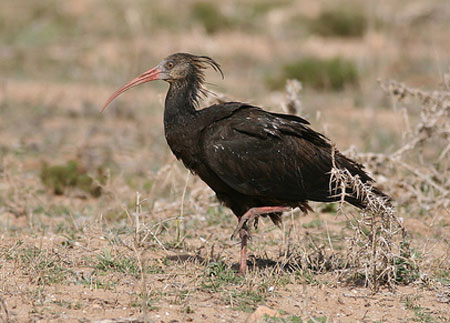
Northern Bald Ibis is one of the celebrities on Morocco in Spring Photo: James Lidster
As early spring touches Morocco, the country bursts into life, offering the visiting birdwatcher some truly memorable experiences. We’ll begin in Marrakech before heading into the dramatic mountains of the High Atlas. Here we’ll seek out a variety of mountain birds, and in particular the elusive African Crimson-winged Finch, a species that is probably seen more easily here than anywhere else.
Perhaps most exciting of all will be our trip through the desert areas near Boumalne Dades and Merzouga along the edge of the spectacular Sahara. In this beautiful landscape are more special birds, including such classic desert species of North Africa as Cream-colored Courser, Thick-billed Lark, and Desert Sparrow. We’ll then travel down to the Atlantic coast and Agadir, where we hope to find Northern Bald Ibis, one of the world’s rarest birds, as well as a variety of waterbirds on the Souss and Massa estuaries.
Day 1: The tour begins this evening in Marrakech.
The tour was great and Ethan was a fantastic guide. The scenery and birds were both awesome! This tour takes you through a variety of landscapes that amaze at every turn.
Amanda B., Apr 2023
Days 2-3: From Marrakech we’ll drive south to the Atlas mountains where we have two days exploring this wonderful area. African Crimson-winged Finch is our primary goal, often found amongst flogs of Rock Sparrows and ‘Atlas’ Horned Larks (a potential split). We’ll also see African Blue Tit and ‘North African’ Chaffinch and (the latter already regarded by many authorities as a full species).
The three countries of Morocco, Tunisia and Algeria make up the Maghreb, and this area has several endemic species/subspecies depending on whose taxonomy you follow. With luck this mountainous terrain will provide us with two of these—Moussier’s Redstart and Atlas Wheatear. The high meadows, sometimes covered in snow even in April, are home to both Yellow-billed and Red-billed Choughs, and Water Pipit and White-throated Dipper may be found nearby. Overhead we may see the local ‘Atlas’ race of Long-legged Buzzards and, having now recovered from years of persecution, perhaps a mighty Lammergeier. Nights near Oukaimeden.
Day 4: After an early breakfast we’ll leave the mountains behind, perhaps pausing en route for Levaillant’s Woodpecker. From the flat plains of Marrakech we’ll turn back uphill and make the long, scenic drive to Boumalne via the spectacular Tizi-N’Tichka Pass. As the road climbs into the hills, we may start to see some more raptors, possibly including migrant Booted Eagle and Short-toed Snake Eagles. Before lunch we’ll target another North African endemic, Tristram’s Warbler. If time allows, we’ll make a stop in Ouarzazate to explore the dam at Mansour Edhabbi. Here we’ll have a chance of seeing Blue-cheeked Bee-eater, Eastern Olivaceous Warbler and Maghreb Lark, as well as Ruddy Shelduck, Marbled Duck, Eurasian Spoonbill, and a selection of waders and migrants. Night in Boumalne Dades.
Day 5: We’ll head out before breakfast to explore the famous Tagdilt region. Our targets for the day will include Black-bellied Sandgrouse, Cream-colored Courser, Desert and Red-rumped Wheatears, Trumpeter Finch, and a selection of larks including Greater Hoopoe, Temminck’s, both Greater and Mediterranean Short-toed, and with luck the highly nomadic Thick-billed. At this time of year migration is often evident over the desert as small groups of European Bee-eaters and swifts (both Pallid and Common) work their way north. Night in Boumalne Dades.
Day 6: The scenery will change again today as we leave behind the high, stony desert and travel to a sandier habitat. New birds will continue to appear, with Brown-necked Raven, Bar-tailed Lark, Scrub Warbler, and White-crowned Wheatear all possible. If we’re lucky, we may be able to catch up with Maghreb Wheatear, Pharoah Eagle Owl and Lanner Falcon en route. After passing the dramatic Ziz Gorge with its unexpected palm-lined valley, we’ll make our way to Erfoud, the gateway to the Sahara. On the edge of the desert, we could see a selection of migrant warblers around the hotel, ranging from Western Subalpine and Sardinian to Western Bonelli’s and Western Olivaceous, as well as Eurasian Wryneck, Hoopoe, Bluethroat, Woodchat Shrike, and European Bee-eater. The highly localized Eastern Olivaceous Warbler (race reiseri) sometimes breeds near the hotel. Night in Erfoud.
Day 7: We’ll spend the whole day in four-wheel-drive vehicles exploring this fascinating desert habitat. We’ll be searching for a number of classic desert birds including Desert Sparrow, Bar-tailed and Greater Hoopoe Larks, Spotted and Crowned Sandgrouse, Cream-colored Courser, Desert Grey Shrike, and African Desert Warbler. We’ll also have another chance of catching up with Lanner Falcon and Pharoah Eagle Owl is a real possibility. We also hope to find a beautifully camouflaged Egyptian Nightjar at a daytime roost. Night in Erfoud.
Day 8: We’ll have another long journey today, but not without some birding along the way. Blue-cheeked Bee-eaters are often seen along the route, and we’ll stop at likely looking spots to check for migrants. After another picnic lunch we’ll continue to Ouarzazate where, depending on our arrival time, we may be able to check out the shoreline of the nearby reservoir or bird some of the lush green gardens along the river. Night in Ouarzazate.
Day 9: There will be more time this morning for birding around the reservoir. In recent years this has been a reliable site for Ruddy Shelduck, and migrant waders could include Wood and Curlew Sandpipers, Ruff, Little Stint, and Black-winged Stilt. Passerines will also be present, and careful checking through groups of Yellow Wagtails could produce three different subspecies as well as the Moroccan White Wagtail—species or not, the latter is a stunning bird to see. Migrant harriers often drift through, with Montagu’s and Western Marsh the most likely, and we may see Greater Flamingo and Black-crowned Night and Purple Herons. Our destination this evening is coastal Agadir, and once away from the reservoir we’ll drive through more mountainous habitat, home to Bonelli’s Eagle, Black Wheatear, and Western Orphean Warbler, stopping in Tazenahkt for a coffee break and the chance to haggle for a carpet to take back home from Morocco’s ‘carpet city’. Night in Agadir.
Day 10: Driving alongside long Atlantic rollers, we’ll head north of Agadir in search of one of Morocco’s most iconic birds, the Northern Bald Ibis. At this time of the year, visiting the breeding cliffs of this endangered species is quite rightly not allowed, but we may find them in coastal fields, where they can sometimes be very confiding. At nearby Tamri we’ll check the estuary, where the ibis sometimes drop in to bathe, as do hundreds of gulls, often including the increasingly numerous Audouin’s and Slender-billed. If there is an onshore wind, seawatching may produce Northern Gannet, Cory’s Shearwater, and occasionally a skua or even a Razorbill. Migrants may include Western Black-eared Wheatear, Tawny Pipit, and Eurasian Thick-knee, while European Serin, Zitting Cisticola, and House Bunting are all common breeders. We’ll spend the afternoon around the Souss estuary, where anything can, and frequently does, turn up. Large wading birds such as Greater Flamingo, Eurasian Spoonbill, and White Stork can be numerous, and we’ll check the gulls and terns for species such as Mediterranean Gull and Gull-billed and Caspian Terns. Waders are often plentiful and the selection ever-changing, from both Bar-tailed and Black-tailed Godwits to Eurasian Greenshank, Black-bellied and Kentish Plovers, and Little Stint. The nearby scrub holds plenty of Maghreb Magpies as well as a special bird widespread throughout Africa south of the Sahara, the striking Black-crowned Tchagra. Night in Agadir.
Day 11: Just as famous as the Souss estuary is the Oued Massa, about an hour south of Agadir. Here the dry stone walls provide ideal perches for Little Owls, Thekla Larks, and wheatears, and the neatly farmed agricultural areas are excellent for Laughing Doves and European Turtle Doves, as well as Barbary Partridge, “Sahara” Great Grey Shrike, Moussier’s Redstart, and Cirl Bunting. The once brackish lagoon inland of the dunes can hold a variety of waders and herons, and walking along its length provides a great opportunity to scan for raptors, with Osprey, Bonelli’s Eagle, and Black-winged Kite all possible. After lunch we’ll explore more agricultural areas inland where we may find Little Bittern, Squacco and Purple Herons, and Brown-throated Martin, the latter at one of its few Western Palearctic locations. Night in Agadir.
Day 12: The tour concludes this morning at the airport in Agadir.
Updated: 22 May 2023
Prices
- 2025 Tour Price : $3,450
- Single Occupancy Supplement : $320
Notes

Questions? Tour Manager: Erin Olmstead. Call 1-866-547-9868 (US or Canada) or (01) 520-320-9868 or click here to email.
* Tour invoices paid by check carry a 4% discount. Details here.
Maximum group size 9 with one leader.
Transfer back to the Marrakech airport from Agadir (where the tour concludes) is available.
